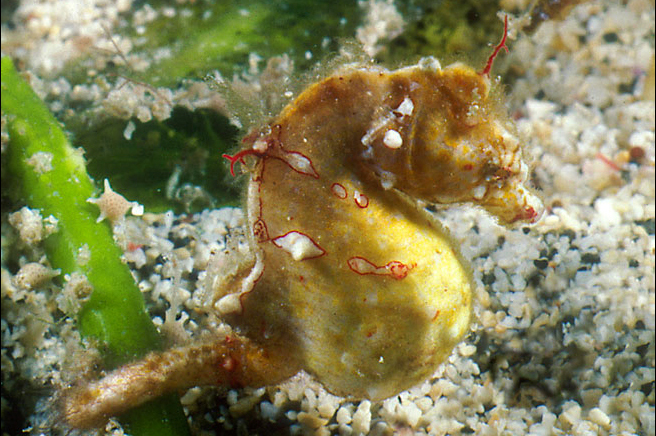Coleman's Seahorse, Hippocampus colemani Kuiter 2003

Coleman's Seahorse, Hippocampus colemani, near Erscott's Hole, Lord Howe Island lagoon, 5 m - paratype AMS I41181-002, in situ. Source: Neville Coleman, colour version of Fig. 2, in Kuiter (2003) Records of the Australian Museum 55: 113-116.. License: All rights reserved
A small pale yellowish seahorse with white circular or elliptical markings outlined with thin red lines on the trunk, tail slightly more brownish with red markings, several dusky brown bands radiating from the eye, and brownish-red dermal appendages.
Coleman's Seahorse, Hippocampus colemani Kuiter 2003
More Info
|
Distribution |
Known from Lord Howe Island in the Tasman Sea. Elsewhere the species may occur in Papua New Guinea, Taiwan and southern Japan. At Lord Howe Island, the species was found in the lagoon on coarse sand amongst Zostera and Halophila seagrasses with fine filamentous algae on their leaves that matched the filaments on the seahorse. |
|
Features |
Dorsal fin 12-13; Anal fin absent; Pectoral fin 10; trunk rings 12; tail rings 27-29; subdorsal rings about 4. Spines reduced to low tubercles, snout spine present, large spine on the eighth lateral and fifth and 12th superior trunk ridges, wing-like-protrusions immediately posterior to head, largest tubercles below dorsal-fin base and on lateral part of head, some with dermal appendages. Nasal spine present as a well-developed ridge before the eye. Coronet low, rounded with a tentacle-like dermal appendage anteriorly. |
|
Size |
Height to about 22 mm. |
|
Colour |
Body mostly pale whitish to yellowish; trunk with white circular or elliptical markings, outlined with narrow red lines; shoulder-ring tubercles white; head white on nape above eyes, extending over snout to tip of mouth; several dusky brown bands radiating from eye; dermal appendages brownish-red; tail slightly more brownish with red markings. |
|
Feeding |
Unknown; presumably feeds on minute invertebrates. |
|
Biology |
Sexes separate, with males brooding the eggs and giving birth to tiny independent young. The female uses an ovipositor to transfer her eggs into an elaborate enclosed pouch under the abdomen of the male. The male not only fertilizes the eggs inside the pouch and provides physical protection for the developing embryos, he also osmoregulates and aerates the embryos and may provide some nourishment until the offfspring are born. |
|
Conservation |
Listed under Appendix II of the Convention on the International Trade in Endangered Species of Wild Flora and Fauna (CITES). Marine Listed under the Federal Environment Protection and Biodiversity Conservation Act 1999 (EPBC Act 1999). |
|
Remarks |
Coleman's Seahorse may also occur in Indonesia, Papua New Guinea, Taiwan, and the Ryukyu Islands, Japan. However, Allen & Erdmann (2012) suggest the possibility that these may form a cryptic species complex. |
|
Similar Species |
Coleman's Seahorse differs from Pontoh`s Pygmy Seahorse, Hippocampus pontohi, in having a low and rounded coronet, s. a more distinct and angular coronet in H. pontohi. |
|
Etymology |
The species is named for Neville Coleman who discovered H. colemani at Lord Howe Island. |
|
Species Citation |
Hippocampus colemani, Kuiter 2003. Rec. Aust. Mus. 55: 113, figs. 1-4. Type locality: Lord Howe Island. |
|
Author |
Bray, D.J. & Thompson, V.J. 2020 |
|
Resources |
Coleman's Seahorse, Hippocampus colemani Kuiter 2003
References
Allen, G.R. & Erdmann, M.V. 2012. Reef fishes of the East Indies. Perth : Tropical Reef Research 3 vols, 1260 pp.
Gomon, M.F. & Kuiter, R.H. 2009. Two new pygmy seahorses (Teleostei: Syngnathidae: Hippocampus) from the Indo-West Pacific. aqua, International Journal of Ichthyology 15(1): 37-44.
Kuiter, R.H. 2003. A New Pygmy Seahorse (Pisces: Syngnathidae: Hippocampus) from Lord Howe Island. Records of the Australian Museum 55: 113-116. https://doi.org/10.3853/j.0067-1975.55.2003.1382
Kuiter, R.H. 2009. Seahorses and their relatives. Seaford, Australia : Aquatic Photographics pp. 331.
Lourie, S.A. & Kuiter, R.H. 2008. Three new pygmy seahorse species from Indonesia (Teleostei: Syngnathidae: Hippocampus). Zootaxa 1963: 54-68.
Ouyang, L. & Pollom, R. 2017. Hippocampus colemani. The IUCN Red List of Threatened Species 2017: e.T47728602A47736420. https://dx.doi.org/10.2305/IUCN.UK.2017-3.RLTS.T47728602A47736420.en. Downloaded on 15 September 2019.






